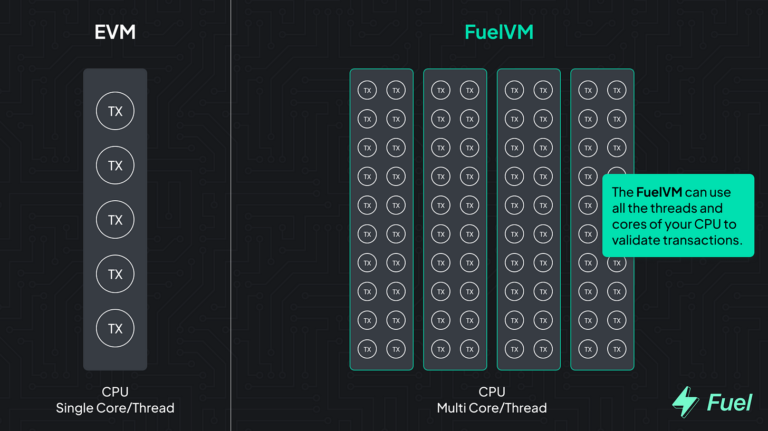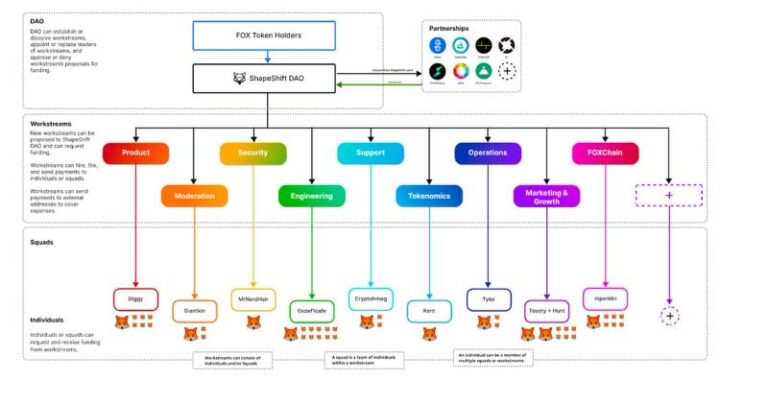Key Insights
- Babylon Finance is an Ethereum-based asset management platform that allows individuals and groups to create custom investment communities known as Gardens.
- Garden strategies can be built through a no-code UI that allows users to mix and match operations from various DeFi protocols (e.g., Uniswap, Aave, Lido, Yearn, Convex, etc.).
- Community members (Garden investors) can either be hands-off and simply deposit their capital or take an active role in voting on and creating strategies, and receive a share of earnings for doing so.
- In the broader DeFi asset management landscape, Babylon has carved out a niche for itself by coupling a transparent, trust-minimized, and decentralized process around investing with the ability to create active strategies.
- Babylon itself and many of its largest Gardens had heavy exposure to the Rari/Fuse protocol before it was hacked, absorbing sizable losses as a result.
- In addition to continuing to amend the downstream effects of the Rari/Fuse hack, Babylon is working on simultaneously expanding the protocol/increasing customizability and simplifying the user experience.
Over the past few years, there’s been a surge in retail investing. While part of this can be chalked up to market conditions (e.g., rock-bottom interest rates), it’s hard to overstate the role of the internet.
In addition to opening up access to markets, the internet has given investors the ability to share information in new ways and coordinate with other market participants. This has led to the rise of robo-advisors, a plethora of complex and innovative ETFs, and investment communities ranging from Real Vision to wallstreetbets. These platforms have given everyday investors a way to inform their decision-making with the help of subject-area experts and peers. In some cases, they have even spurred deliberate, organized, collective action (e.g., GME short squeeze).
However, moving from the traditional, analog financial system to the internet’s native financial system, also known as decentralized finance (DeFi), now allows users to go a step further. Thanks to smart contracts, individuals and groups can now coordinate directly, permissionlessly, and transparently without having to give up trust.
Babylon Finance, an Ethereum-based asset management platform, leverages these features to let individuals and groups create investment communities. This allows aligned participants to invest in DeFi together. Community members (investors) can either be hands-off and simply deposit their capital or take an active role in voting on and creating strategies, all while receiving a share of earnings for doing so.
By opening and democratizing the process around asset management, Babylon Finance offers something for everyone — from the uninitiated to the expert.
Background
In late-2020, Ramon Recuero, founder of Babylon Finance, had grown tired of fielding the same questions around investing in crypto from friends and family. He decided to streamline the process. Recuero put their capital in a smart contract and coordinated with everyone through a Telegram channel about their investments. While this system was successful, returning over 1,000%, it was also time-consuming.
To scale the process, Recuero founded Babylon Finance to allow groups to coordinate and invest in DeFi using Ethereum smart contracts.
Babylon Finance launched its gated beta (Settlers Beta) in July 2021. After about nine months later, at the beginning of April 2022, after adding a number of features and integrations, Babylon Finance held its public launch.
How Babylon Works
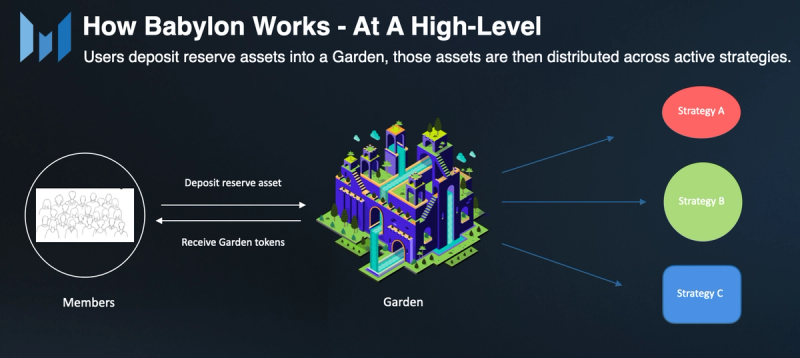
Gardens
At a high level, Babylon is centered around its non-custodial investment communities, called “Gardens.” Gardens can be created permissionlessly, for almost any purpose.
In addition to setting forth an investment thesis, Garden creators can customize a number of parameters including:
- The name of the Garden and the Garden token (ERC-20 tokens that represent member ownership in a Garden)
- Garden access (who can join and vote on or create strategies)
- Reserve asset (used to deposit/withdraw and calculate returns; current options are DAI, USDC, WETH, and WBTC)
- Minimum deposit size and maximum Garden capacity
- Profit allocation
- Voting, duration, and liquidity thresholds for strategies
However, once finalized, the aforementioned parameters can’t be changed.
The most popular Garden on Babylon, as of this writing, is The Fountain of ETH. The Garden’s goal is to “accumulate ETH through low-risk strategies without exposure to the fiat price.” Its net asset value (NAV) currently hovers around 1,500 ETH.
Members
Once a Garden is set up, it needs capital from users.
From a user perspective, a Garden is very similar to a rolling fund. For a user to deposit capital, the Garden first has to be open; under its maximum capacity; and either public or have included the user in its member whitelist (the set of addresses allowed to deposit). Once these conditions are met, the user can deposit the reserve asset in a sum greater than the minimum deposit, receive Garden tokens in exchange and thus become a Garden member. There is a 0.5% management fee on deposits.
The protocol and by extension the Gardens are non-custodial, which means users retain ownership of their capital.
Strategies
Each Garden creates value for these members by running a strategy (or multiple strategies) in line with its investment thesis. Permissions around proposing and voting for strategies can vary by Garden — from anyone who deposits capital into the Garden (members) to specific, whitelisted addresses.
There are different ways to create strategies. One method is using the no-code user interface (UI) available at babylon.finance. This layer of abstraction allows prospective strategists to easily mix and match operations on various supported DeFi protocols (e.g., Uniswap, Aave, Lido, Yearn, Convex, etc.). Another recently released feature allows strategists to code their own custom logic and create adapters to new DeFi protocols. While there are caveats (namely that these custom integrations can only be used by ‘unverified’ Gardens that allow them), these custom integrations still represent a step change in terms of the design space for strategists.
In addition to designing the mechanics of a strategy, strategists can also specify other features including:
- Expected return
- Duration
- Maximum % to be spent on gas
- Maximum % slippage per trade
- Maximum allocation (% of Garden principal and amount of reserve asset)
- Their own stake (locked for the duration of the strategy)
After submission, Garden members can cast votes for the candidate strategy. Voters stand to gain if a strategy they vote for is executed successfully, sharing a maximum of 15% of the total profit with the strategist. The default breakdown is 10% to the strategist and 5% to voters. And voters don’t just stand to gain by upvoting strategies, but downvoters get to split the strategist’s stake if a strategy ends up being unprofitable.
Once a given candidate strategy reaches the Garden-specified quorum, it enters a cooldown period before automatically executing (gas fees are split between Garden members). And while each strategy has a preset duration, strategists can unilaterally close their proposed strategy at any point.
After a strategy is completed (or closed), the assets in the strategy will be converted back into the Garden’s reserve asset. In addition to the (up to) 15% slated for strategists and voters, an additional 5% of the profit goes toward the Babylon Finance treasury.
Given the structure of the protocol and the process involved around approval, strategies tend to be designed for the medium-long term (e.g., weeks/months rather than hours/days). In some ways they reflect traditional exchange-traded funds (ETFs), deploying capital in a passive, systematic yet strategic manner.
An example of a strategy is the Aladdin DAO stETH strategy in The Fountain of ETH. It’s a two-step strategy that first provides liquidity to the stETH/ETH pair in Curve and then stakes those Curve LP tokens in the Aladdin DAO’s Concentrator vault.
Withdrawing Capital
If there’s enough idle capital in the Garden, members can withdraw with no penalty by exchanging their Garden tokens for the commensurate reserve assets. However, if there isn’t enough capital available, members have to wait for a strategy to end or pay a 2.5% penalty to withdraw immediately (which gets distributed to the Garden).
Babylon for DAO Treasuries
While Babylon’s platform was initially created for retail investors, its tools have turned out to be useful for DAOs, in particular their treasuries.
Although Babylon just recently began to push into this market, the obvious, primary use case is to enable decentralized, transparent treasury management. This management style could be achieved either by creating a Garden and allowing members to create/vote on strategies or using the pre-existing Babylon Gardens to create a portfolio of investment strategies. Beyond generating yield, Babylon could also be used to create a staking mechanic or automate processes like buybacks by swapping back strategy profits into a project’s ERC-20 governance token.
Babylon Finance Token (BABL)
BABL is Babylon Finance’s Ethereum-based, ERC-20 governance token.
Protocol governance takes place on-chain using Babylon Governor. BABL holders can submit and vote on proposals regarding treasury management, integrations, system updates, protocol fees, and more.
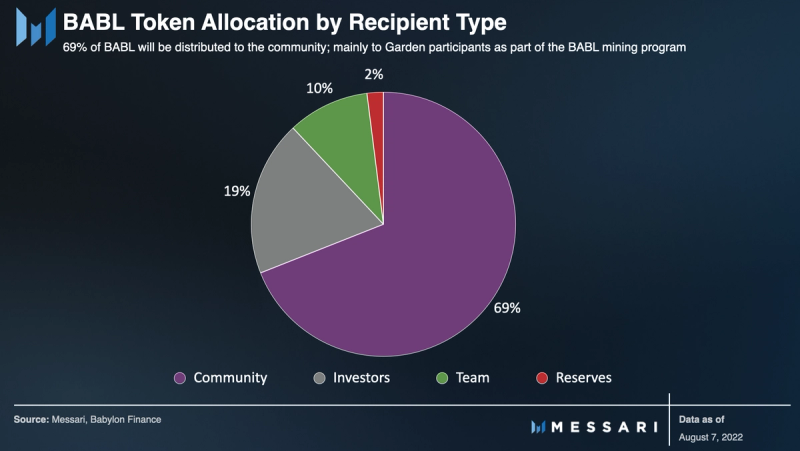
The distribution breakdown of the initial supply is 19% to seed investors over a three year vesting period, 10% to team members over a four year vesting period, 2% reserved for future fundraising, and 69% for the community.
Out of the 69% allocated for the community, 50% is slated for the BABL mining program, 14% is allocated to its treasury, and the remaining 5% will go towards liquidity bootstrapping initiatives.
The BABL mining program is a 10 year program that rewards participation in Babylon. It uses BABL to boost strategy yields for all involved parties (members, strategist, voters, and the Garden creator).
In addition to governance, BABL holders can stake their BABL in The Heart of Babylon Garden and receive hBABL in return. hBABL is a vote escrowed token that adopts the popular veCRV model, meaning a longer lock results in higher voting power.
The Heart of Babylon Garden is also set up to employ a number of popular tokenomics strategies to generate yield for BABL stakers and generally bolster the protocol. On the one hand, it uses collected fees from Gardens to buy back BABL and distribute it to hBABL holders (10%) and the Babylon Finance treasury (45%). It also uses BABL to invest in other Gardens based on staker vote (20%), provide liquidity to the BABL-ETH pair (10%), and supply the Babylon Shield (5%) to insure against incidentals.
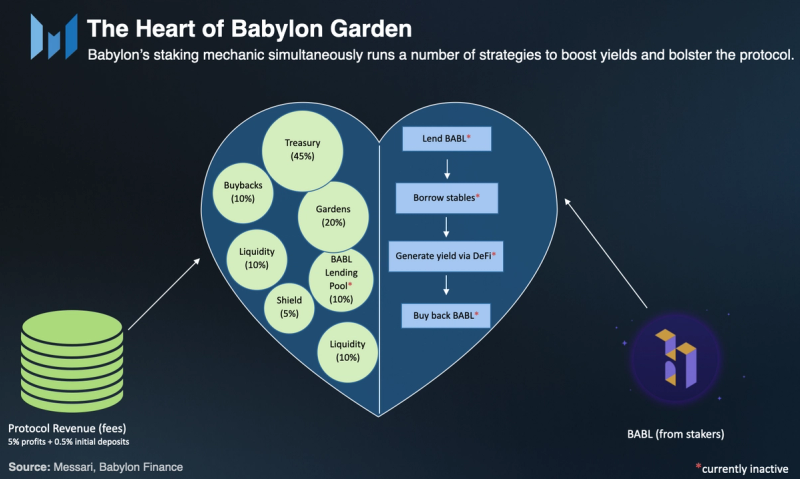
While the strategies outlined above are still active, a number of strategies used to generate additional yield for The Heart of Babylon were deprecated after the Rari/Fuse hack. These strategies involved lending out part of the protocol revenue (10%) and 85% of staked BABL through Babylon’s Gold Lender Fuse pool, and then borrowing against the lent sum to generate additional yields across DeFi. Thus, while the target APR for The Heart is set at 30%, stakers should expect a much lower yield for the time being.
However, stakers can boost their staking yield (up to 10%) through Babylon’s Bond program. Looking forward, the Babylon Finance team is also looking for at least two new protocols to re-enable lending and borrowing using BABL.
Traction

Since its gated beta in mid-November 2021 through the first two months after its public launch (April 1, 2022), Babylon grew its total value locked (TVL) in USD terms and more than tripled its TVL measured in ETH. This was despite a choppy, declining market and Terra/LUNA collapse. However, the mid-June contagion proved to be too much.
In addition, Babylon itself and many of its largest Gardens had very heavy exposure to the Rari Fuse protocol. Around mid-June, Rari/FEI officially reneged on their promise to compensate those affected by the exploit. As a result, the $3.41 million in tokens taken from Babylon’s Golden Lender Fuse pool were officially marked down to 0. While the Babylon treasury tried to backstop the loss, they were only able to cover about $100,000 and 34 ETH, given the nascent state of the treasury.
Since the sharp drop, Babylon’s TVL has remained about flat (in ETH and USD), but the Babylon team and community are currently working on rebounding and expanding the protocol.
Competitive Landscape
Seeing how smart contracts enable trustless coordination, it’s no surprise that Babylon Finance isn’t alone in the decentralized, non-custodial asset management space.

However, Babylon Finance has carved out a niche for itself by coupling a trust-minimized/decentralized investing process with the ability to run active strategies. Other existing asset management protocols with active strategies (e.g., Enzyme Finance and dHEDGE) mimic the traditional hedge fund model with a single manager and a “two and twenty” fee structure. Babylon differentiates itself by allowing for a transparent, decentralized decision making process that can tap into the collective intelligence of an aligned community and shares the rewards (performance fees) with them as well.
On the other hand, there are transparent, trust-minimized asset management protocols (e.g., Yearn, Index Coop, and TokenSets) that are passive and mimic traditional ETFs/indices. In addition to lacking a flexible, active option (around capital allocation and rebalancing), these protocols also tend to have barriers around product creation. The barriers range from requiring coded strategies (Yearn) to complex community-wide approval processes (Index Coop) to narrow design spaces (TokenSets).
Nonetheless, there are obviously massive markets for both active single-manager strategies and fixed, long-term, passive strategies. This is where Babylon’s flexible Garden and strategy creation comes into play. Not only can Garden and strategy creators tap the aforementioned ends of the spectrum, but they can also fill the space inbetween.
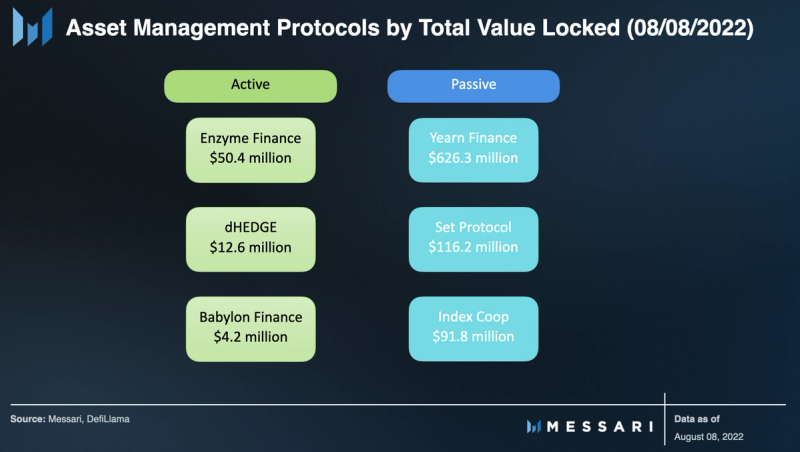
Despite having a comprehensive product with a large potential market, Babylon has not been able to live up to its potential thus far. Some of this can be ascribed to unfortunate timing and circumstances outside the Babylon team’s control. By the team and the community’s admission, another factor could be the complexity and expansive scope of the protocol. Additionally, its unique niche (active community management) remains new and unproven with no real analogs in the traditional finance world.
If Babylon can persist despite macro headwinds and setbacks, it does have potential. However, the market seems to see this as well and new, closer competitors are on the horizon. Two notable projects to keep an eye on are Syndicate, focused on on-chain investment clubs for Web3 and real-world assets (as opposed to DeFi), and Enso Finance, which seems the closest to Babylon in terms of functionality but is still in private beta.
Roadmap
The Babylon Finance roadmap is currently working towards three main objectives: continuing to amend the consequences of the Rari/Fuse hack, expanding the protocol, and increasing customizability.
The former is still being (publicly) mulled over by the Babylon team and community in the Babylon Discord. The current plan centers around using the Babylon treasury’s BABL to multiply rewards in the affected Gardens by 2.5x. The part of the plan still being ironed out is the distribution method, in particular around how to alleviate some of the expected sell pressure. Once the community discussion reaches consensus, a proposal will be put up for an on-chain tokenholder vote (BIP-24).
Protocol expansion will include adding support for layer-2 solutions, other layer-1 chains (i.e., Avalanche and Fantom), additional DeFi protocols, and NFTs.
One part of the customizability roadmap aims to improve tooling for DAO treasuries and enable them to select custom reserve assets. Another component revolves around strategy customization, increasing the design space for strategists and member input using “micro-governance voting” as well as allowing strategies to access other public Gardens.
Risks
Babylon has two main risk vectors: the protocol and its integrations.
The Babylon Finance team has been fairly diligent in terms of security, conducting eight external audits to date and maintaining an (up to) $100,000 bug bounty program. This work seems to have paid off, seeing as the protocol hasn’t been directly compromised in any way to date.
Another risk for the protocol is the treasury, which didn’t have a chance to build out during the last upcycle and took big hits working to backstop the Rari/Fuse hack and stETH-ETH depeg. However, Babylon has started to address this by increasing the treasury’s share of protocol revenue to 45% (from 10%).
Finally, Babylon’s unique, untested value proposition paints an uncertain (albeit promising) picture.
The second risk vector is much harder to control: DeFi integrations. In addition to the Rari/Fuse hack, the Babylon Treasury also lost a significant sum of capital (125 ETH) backing up the Fountain of ETH during the stETH-ETH depeg. Totally mitigating these risks is difficult, given the nature of the protocol (aggregation/composability). However, the Babylon team and community have started taking steps to diversify exposure (i.e., for new BABL lending/borrowing protocols) and to cover incidentals without leaning on the treasury (i.e., Babylon Shield).
Closing Thoughts
Despite only being live for a few months, Babylon has faced more than its fair share of setbacks. Nonetheless, the protocol, team, and community have persisted. If they can continue to weather the challenges and learn lessons along the way, Babylon Finance has all the parts necessary to become an integral tool for DeFi asset management.
Even though the competition is stiff, the category is still in its infancy. and the beauty of Babylon’s model is that it has something to offer for just about everyone.
Let us know what you loved about the report, what may be missing, or share any other feedback by filling out this short form.
This report was commissioned by Babylon Finance, a member of Protocol Services. All content was produced independently by the author(s) and does not necessarily reflect the opinions of Messari, Inc. or the organization that requested the report. Paid membership in Protocol Services does not influence editorial decisions or content. Author(s) may hold cryptocurrencies named in this report.
Crypto projects can commission independent research through Protocol Services. For more details or to join the program, contact ps@messari.io.
This report is meant for informational purposes only. It is not meant to serve as investment advice. You should conduct your own research, and consult an independent financial, tax, or legal advisor before making any investment decisions. The past performance of any asset is not indicative of future results. Please see our terms of use for more information.



